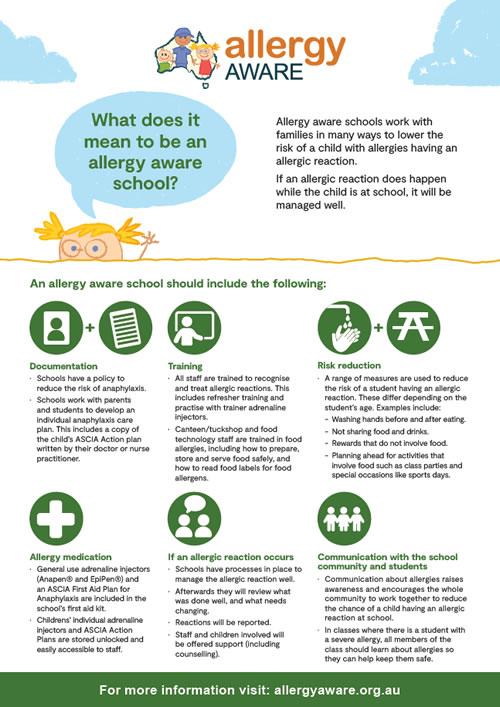What does it mean to be an allergy aware school?
Allergy aware schools work with families in many ways to lower the risk of a child with allergies having an allergic reaction. If an allergic reaction does happen while the child is at school, it will be managed well.

An allergy aware school should include the following:
Documentation
Schools have a policy to reduce the risk of anaphylaxis.
Schools work with parents and students to develop an individual anaphylaxis care plan. This includes a copy of the child’s ASCIA Action plan written by their doctor or nurse practitioner.
Training
All staff are trained to recognise and treat allergic reactions. This includes refresher training and practise with trainer adrenaline devices.
Canteen/tuckshop and food technology staff are trained in food allergies, including how to prepare, store and serve food safely, and how to read food labels for food allergens.
Risk reduction
A range of measures are used to reduce the risk of a student having an allergic reaction. These differ depending on the student’s age. Examples include:
Washing hands before and after eating.
Not sharing food and drinks.
Rewards that do not involve food.
Planning ahead for activities that involve food such as class parties and special occasions like sports days.
Allergy medication
General use adrenaline devices and an ASCIA First Aid Plan for Anaphylaxis are included in the school’s first aid kit.
Childrens’ individual adrenaline devices and ASCIA Action Plans are stored unlocked and easily accessible to staff.
If an allergic reaction occurs
Schools have processes in place to manage the allergic reaction well.
Afterwards they will review what was done well, and what needs changing.
Reactions will be reported.
Staff and children involved will be offered support (including counselling).
Communication with the school community and students
Communication about allergies raises awareness and encourages the whole community to work together to reduce the chance of a child having an allergic reaction at school.
In classes where there is a student with a severe allergy, all members of the class should learn about allergies so they can help keep them safe.
What are the Best practice guidelines for anaphylaxis prevention and management in schools?
The Best practice guidelines for anaphylaxis prevention and management in schools were developed by the National Allergy Council in consultation with key stakeholder organisations, principals and staff working in the school sector, allergy specialists and parents of children with allergies.
The Best practice guidelines aim to help individual schools prevent and manage anaphylaxis.
They include sample documents and templates to help schools reduce the risk of anaphylaxis, while supporting students to participate in the full range of school life.
Why did we develop the Best practice guidelines?
Around 1 in 20 school-aged children have a food allergy. Other children are allergic to insect stings and bites.
Severe allergic reactions (called anaphylaxis) can be life threatening.
Content created November 2023